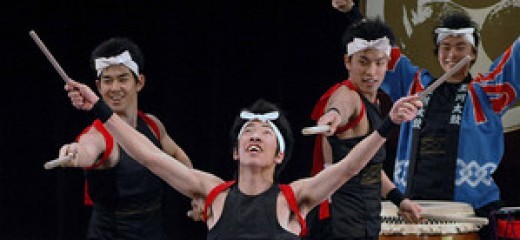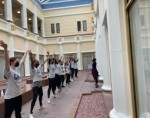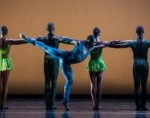
Cherry Blossoms: Viewing Japanese Dance In Philadelphia
by Ellen Gerdes
I’ve set my gmail home screen to a pattern called “cherry blossom.” This is a reminder to me of my own consumption of “Asianness”– souvenirs, clothing, food... even dance. I entered Chinese dance first as a consumer of performances and festivals in the United States and then abroad. When I lived in China, I confronted my own romanticization of Chinese dance via what I considered my search for Chinese “traditional” dance amongst the salsa, ballet, and hip-hop ever-available to me there.With that in mind, I am increasingly interested in how Asian dance is presented and viewed in the United States. Asian inter-cultural festivals, such as the Subaru Cherry Blossom Festival, often showcase more mainstream dances deemed traditional, which confirm the familiar conception of Asia as traditional and the West as progressive.
Recently the Subaru Cherry Blossom Festival presented both kabuki dance and the Tamagawa University Taiko Dance and Drumming troupe. The Crazy Cloud Collection by San Francisco’s inkBoat and Japanese butoh master artist, Ko Murobushi, was presented a few weeks later by the Painted Bride as part of a separate series, “Under the Cherry Moon.” Cumulatively, the three concerts raised questions for me about our comprehension of these forms and whether we understand here how to properly value them. The cultural stereotypes ascribed to them are also problematic.
***
I had only ever seen kabuki on video, so I was thrilled to see it live. Now on UNESCO’s list of Intangible Cultural Heritage masterpieces (like a list of endangered species for art and culture), kabuki was initially conceived of as “avant-garde” or “bizarre” theater. With over four hundred years of history, a separate dance technique, called nihon buyo, emerged.
At the Kimmel Center one lone singer playing the shamisen (a three-stringed Japanese instrument) knelt on a cloth upstage as an older woman holding a long-handled basket stepped slowly downstage, knees close together and feet turned in – her purple kimono creating puddles around her feet. “I am being dragged away, further out into the sea,” the vocalist cried as the dancer skittered her feet in a serpentine path, swept back and forth by the waves.
The audience reacted throughout to the onstage costume changes – a brilliant revealing of new layers and colors. When the lights came up on nihon buyo master Bando Katoji in white face make up and a gold and black kimono with long, wide sleeves, the audience gasped and someone next to me said, “I am glad they’ve left the essence of kabuki– the costumes.”
In a scene from the “Pearl Diver,”a dancer held a closed paper fan straight to convey the depth of the ocean. Using the fan like a knife, she stabbed at her chest, as if to place a pearl in her wound. She ascended –the fan up above her head, spiraling slowly. Her eyes searched for the surface and I held my breath. I marveled how one gesture, both specific and symbolic, took on multiple abstract resonances.
* * *
My first experience of taiko drumming was at an inter-generational Honolulu street festival; I remember a young boy pounding a drum four times his size and the excitement of watching him up-close. Taiko’s origins are actually traced to early martial beginnings. Save one all-female drum piece with minimal physical reverberations, the men of the Tamagawa taiko troupe performed the drumming.
They executed each loud drumbeat by percussively lunging, turning or jumping. I wondered if the women’s kimonos would get in the way of such full-bodied percussion.
In green kimonos with a cherry blossom pattern, the women cocked their heads side to side as they took small steps backwards, knees close together. With permanent smiles, they maneuvered two paper fans in “Kabuki Dance: Hana-fubuki.”
While many in the audience expressed delight through loud applause and cheers, around me I heard a number of derogatory comments including, “Do they always perform in their underwear?” “Maybe I can find myself a Japanese boyfriend – look how skinny he is!” “Oh the women are so cute, they look like dolls.”
* * *
In reaction to the devastation of World War II, Tatsumi Hijikata and Kazuo Ohno developed butoh as an anti-Western, anti-traditional dance form. At the Painted Bride Arts Center, the audience turnout was dismal for the group inkBoat and Ko Murobushi, student of butoh pioneer Hijikata. In The Crazy Cloud Collection – a danceof illusion, of non-arrival, of suffering even – dancers crawled like spiders and twitched until drenched with sweat. A recorded voice demanded, “Stare at it until your eyes pop out.” Ko showed his bare torso; his older body with protruding scapula served as a reminder of our mortality.
The program cites eccentric Zen Buddhist priest and poet Ikkyu, as source of inspiration for the work: “Who will not end up a skeleton? Cast off the notion that ‘I exist.’ Entrust yourself to the windblown clouds, and do not wish to live forever.” And while the dancers partnered with skulls, I questioned my own ability to truly matter. I imagined eyes popping out of these skulls. Out of my own.
A woman in a black dress hummed faintly with roses held in her mouth, blossoming like multiple lips in a Picasso painting. Another man (whom I believed at first to be the woman) in black underwear and an unbuttoned white dress-shirt stood as if suspended from his sternum, reveling in a slow stream of sand that poured from the ceiling – marking time.
***
You can still see the cherry blossom trees that were first planted in Philadelphia in 1926 as a gesture of friendship by the Japanese Government. Well after World War II, we are asking kabuki and taiko to carry on this cross-cultural diplomacy under the rubric of the Cherry Blossom Festival. Similarly, The Crazy Cloud Collection was funded by the U.S./Japan Cultural Trade Network; yet only a small audience experienced the result of this cross-cultural interaction. The corporate marketing and advertising by Subaru surely affected audience size for its festival. In addition, kabuki and taiko might be more attractive and easy to comprehend for audience members because they fit stereotypes of traditional Japan: kimonos, fans, stringent gender codes, and mystical tales. But butoh’s exploration of death, portrayal of the grotesque, and anti-Western beginnings (its reaction to war and the atomic bombs) do not satisfy our contemporary notion of happiness via uncomplicated multi-culturalism. It isn’t exactly a dance of celebration. The smiles of the taiko dancers and drummers, like cherry trees themselves, serve more easily as symbols for cross-cultural harmony.
Here are questions I am left with at the end of this spring’s Japanese dance presentations:
How did corporate sponsorship and the general popularity of the Cherry Blossom festival influence both the large audience turnout and audience expectation at the kabuki and taiko performances? How could presenters, as the Painted Bride did, challenge the existing rubric for the Cherry Blossom festival by incorporating less mainstream, avant-garde Japanese choreography? How can we move beyond seeing traditional, contemporary, and avant-garde Japanese dance forms as being mutually exclusive?
How do our pre-conceived notions of Japanese culture dictate our expectations as audience members? How do desires for cross-cultural harmony affect our viewing of dance?
How can we be more aware and critical of the language we use in response to Asian bodies on the US stage?
Finally, how can kabuki, taiko, and butoh be promoted as evolving contemporary practices with the capacity to provoke our most current and existential questions?
Kabuki dance, Kimmel Center, March 25, 2012.
By Ellen Gerdes
June 1, 2012










